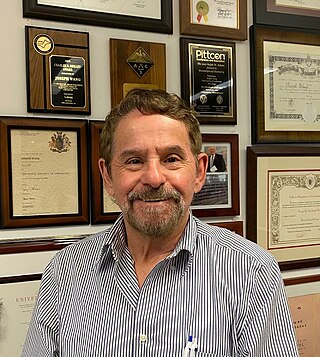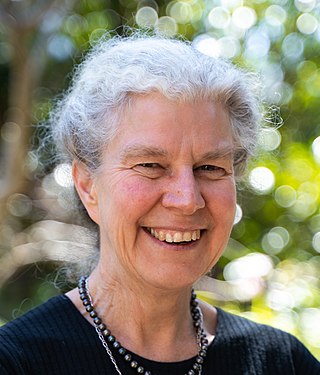Related Research Articles

Sushanta Kumar Bhattacharyya, Baron Bhattacharyya,, was a British-Indian engineer, educator and government advisor. In 1980, he became Professor of Manufacturing Systems at the University of Warwick and founded the Warwick Manufacturing Group. In 2004, he was made a life peer and became a member of the House of Lords.

Joseph Wang is an American biomedical engineer and inventor. He is a Distinguished Professor, SAIC Endowed Chair, and former Chair of the Department of Nanoengineering at the University of California, San Diego, who specialised in nanomachines, biosensors, nano-bioelectronics, wearable devices, and electrochemistry. He is also the Director of the UCSD Center of Wearable Sensors and co-director of the UCSD Center of Mobile Health Systems and Applications (CMSA).
Tia Emmetine Keyes is a professor of physical chemistry at the School of Chemical Sciences, and a member of the National Centre for Sensor Research at Dublin City University.
Fraser Andrew Armstrong is a professor of chemistry at the University of Oxford and a Fellow of St John's College, Oxford.

Lesley Jane Yellowlees, is a British inorganic chemist conducting research in Spectroelectrochemistry, Electron transfer reactions and Electron paramagnetic resonance (EPR) Spectroscopy. Yellowlees was also elected as the president of the Royal Society of Chemistry 2012–14 and was the first woman to hold that role.
Sir David Klenerman is a British biophysical chemist and a professor of biophysical chemistry at the Department of Chemistry at the University of Cambridge and a Fellow of Christ's College, Cambridge.
Priscilla Baker is a professor of analytical chemistry at the University of the Western Cape. She is the co-leader of SensorLab, a research platform in electrochemistry that deals with the electrodynamics of materials and sensors. She is an active member of the Academy of Science of South Africa, European Scientific Network for Artificial Muscles (ESNAM) and the Marie Curie International staff exchange scheme (IRSES).
Anna Slater is a Royal Society Dorothy Hodgkin Fellow at the Materials Innovation Factory at the University of Liverpool.
Rachel O'Reilly is a British chemist and Professor at the University of Birmingham. She works at the interface of biology and materials, creating polymers that can mimic natural nanomaterials such as viruses and cells. She is a Fellow of the Royal Society of Chemistry and of the Royal Society.
John S. Fossey was a British chemist. He was a professor of synthetic chemistry at the University of Birmingham in the United Kingdom, and a visiting professor at Henan Normal University and guest professor at East China University of Science and Technology, both in China. His research was in molecular recognition and catalysis, and he was a user of boronic acid derivatives. He was a former industry fellow of the Royal Society.

Jadranka Travaš-Sejdić is a New Zealand academic, and as of 2018 is a professor at the University of Auckland.

Alison Rodger FRSC FRACI FAA CChem is a professor of chemistry at Macquarie University. Her research considers biomacromolecular structures and their characterisation. She is currently developing Raman Linear Difference Spectroscopy and fluorescence detected liner dichroism to understand biomacromolecular structure and interactions with application to the division of bacterial cells.
Linda Faye Nazar is a Senior Canada Research Chair in Solid State Materials and Distinguished Research Professor of Chemistry at the University of Waterloo. She develops materials for electrochemical energy storage and conversion. Nazar demonstrated that interwoven composites could be used to improve the energy density of lithium–sulphur batteries. She was awarded the 2019 Chemical Institute of Canada Medal.

Nguyễn Thị Kim Thanh is a professor of Nanomaterials at University College London. She was awarded the 2019 Royal Society Rosalind Franklin Award for her research and efforts toward gender equality.
Emma Kendrick is Professor of Energy Materials at the University of Birmingham where her work is focused on new materials for batteries and fuel cells. She is a Fellow of the Royal Society of Chemistry and Institute of Materials, Minerals and Mining.
Tracey Maureen Gloster is a chemist at the University of St Andrews UK. Her research interests are in structural biology, chemical biology, glycobiology and carbohydrate processing enzymes.
Katherine B. Holt is a British chemist who is a professor at University College London. She serves as Vice Dean for Education in the Department of Mathematics and Physical Sciences. Her research investigates the development of carbon-based electrodes and electrocatalysis.
Andrea Russell is an American chemist who is a professor at the University of Southampton. She is vice president of the International Society of Electrochemistry. Her research considers the use of spectroscopy to better understand the interface between electrodes and electrolytes.

Susan M. Lunte is an American chemist who is the Ralph N. Adams Distinguished Professor of Chemistry and Pharmaceutical Chemistry at the University of Kansas. She also works as director of the NIH COBRE Center for Molecular Analysis of Disease Pathways. She was awarded the 2023 ACS Award in Analytical Chemistry.
Kathryn Toghill is a British chemist who is Professor of Sustainable Electrochemistry at Lancaster University. Her research considers the development of low-cost energy storage systems, with a particular focus on redox flow batteries.
References
- ↑ "Reactions – Julie MacPherson : The Sceptical Chymist". blogs.nature.com. Retrieved 2018-04-12.
- 1 2 3 4 5 6 Kounaves, Samuel. "Julie Macpherson – 2003 Young Investigator Award". electroanalytical.org. Archived from the original on 2018-04-12. Retrieved 2018-04-12.
- ↑ "Planning for Success: Good Practice in University Science Departments" (PDF). Oxford Research and Policy. Retrieved 2018-04-12.
- ↑ Elsevier. "bio macpherson". www.elsevier.com. Retrieved 2018-04-12.
- 1 2 "Julie Macpherson". royalsociety.org. Retrieved 2018-04-12.
- ↑ "Prof. Julie Macpherson". warwick.ac.uk. Retrieved 2018-04-12.
- 1 2 "Professor Julie Macpherson receives Royal Society Industry Fellowship Award". Department of Chemistry. 2014-05-21. Retrieved 2018-04-12.
- ↑ "University of Warwick Chemistry Professor Awarded Royal Society Industry Fellowship in Partnership with Element Six". www.e6.com. Retrieved 2018-04-12.
- ↑ "Diamonds are for everything". warwick.ac.uk. Retrieved 2018-04-12.
- ↑ "Warwick Electrochemistry and Interfaces Group". warwick.ac.uk. Retrieved 2018-04-12.
- ↑ "Electrochemist wins Royal Society Innovation Award". warwick.ac.uk. Retrieved 2018-04-12.
- 1 2 "Julie Macpherson receives Royal Society Innovation Award – Materials Today". Materials Today. Retrieved 2018-04-12.
- ↑ Macpherson, Julie V. (2015-01-21). "A practical guide to using boron doped diamond in electrochemical research". Physical Chemistry Chemical Physics. 17 (5): 2935–2949. Bibcode:2015PCCP...17.2935M. doi:10.1039/C4CP04022H. ISSN 1463-9084. PMID 25518988.
- ↑ "MSc Modules". warwick.ac.uk. Retrieved 2018-04-12.
- ↑ 95e79a5e1f4b42b1b9566954de89f950. "Julie MacPherson — Sensor CDT". cdt.sensors.cam.ac.uk. Retrieved 2018-04-12.
{{cite web}}: CS1 maint: numeric names: authors list (link) - 1 2 3 Marios. "PLENARY AND KEYNOTE LECTURES". www.eseac2018.com. Retrieved 2018-04-12.
- 1 2 "About Us". warwick.ac.uk. Retrieved 2018-04-12.
- ↑ "Colloid and Interface Science Awards". www.rsc.org. Retrieved 2018-04-12.
- ↑ "RSC Marlow Award Previous Winners". www.rsc.org. Retrieved 2018-04-12.
- ↑ "Julie Macpherson – Young Researcher of the Year". warwick.ac.uk. Retrieved 2018-04-12.